Effects of Power Optimizer Application in a Building-Integrated Photovoltaic System According to Shade Conditions
Abstract
1. Introduction
2. Experimental Methods
2.1. Configuration
2.2. Analysis
3. Results and Discussion
3.1. Daily BIPV Operation Characteristics
3.2. BIPV Power Loss Rate Analysis with and without a Power Optimizer
3.3. Discussion
4. Conclusions
Author Contributions
Funding
Data Availability Statement
Conflicts of Interest
References
- IEA (International Energy Agency). Net Zero by 2050: A Roadmap for the Global Energy Sector. 2021. Available online: https://iea.blob.core.windows.net/assets/deebef5d-0c34-4539-9d0c-10b13d840027/NetZeroby2050-ARoadmapfortheGlobalEnergySector_CORR.pdf (accessed on 5 October 2023).
- BIPVBOOST. Regulatory Framework for BIPV, BIPVBOOST-WP9-T9.2-D9.2_M6-ICARES-20190417-v1.0.doc. 2019. Available online: https://ec.europa.eu/research/participants/documents/downloadPublic?documentIds=080166e5c36a19c8&appId=PPGMS (accessed on 26 October 2023).
- IEA (International Energy Agency). Categorization of BIPV Applications, Report IEA-PVPS T15-12:2021. 2021. Available online: https://iea-pvps.org/wp-content/uploads/2021/09/IEA-PVPS-T15-12_2021_BIPV-categorization_report.pdf (accessed on 25 October 2023).
- Korea Energy Agency New and Renewable Energy Center. Guidelines for Support of New and Renewable Energy Facilities. 2023. Available online: https://www.knrec.or.kr/biz/pds/decree/list.do (accessed on 25 October 2023).
- IEA (International Energy Agency). Analysis of Requirements, Specifications and Regulation of BIPV, Report IEA-PVPS T15-08: 2019. 2019. Available online: https://iea-pvps.org/wp-content/uploads/2020/01/IEA-PVPS_15_R08__Analysis_of_requirements_specifications_regulation_of_BIPV__report.pdf (accessed on 25 October 2023).
- IEA (International Energy Agency). International Definitions of BIPV, Report IEA-PVPS T15-01:2018. 2018. Available online: https://iea-pvps.org/wp-content/uploads/2020/02/IEA-PVPS_Task_15_Report_C0_International_definitions_of_BIPV_hrw_180823.pdf (accessed on 25 October 2023).
- Precedence Research, Solar Microinverter and Power Optimizer Market (By Type: Solar Microinverter, Power Optimizer; By Connectivity: Standalone, On-grid; By Application: Residential, Commercial, Utility)—Global Industry Analysis, Size, Share, Growth, Trends, Regional Outlook, and Forecast 2023–2032. 2023. Available online: https://www.precedenceresearch.com/solar-microinverter-and-power-optimizer-market (accessed on 22 November 2023).
- Bratcu, A.I.; Munteanu, I.; Bacha, S.; Picault, D.; Raison, B. Cascaded DC–DC converter photovoltaic systems: Power optimization issues. IEEE Trans. Ind. Electron. 2010, 58, 403–411. [Google Scholar] [CrossRef]
- Sajadian, S.I.; Ahmadi, R. Distributed maximum power point tracking using model predictive control for photovoltaic energy harvesting architectures based on cascaded power optimizers. IEEE J. Photovolt. 2011, 7, 849–857. [Google Scholar] [CrossRef]
- NREL (National Renewable Energy Laboratory). Photovoltaic Shading Testbed for Module-Level Power Electronics: 2016 Performance Data Update, NREL/TP 5J00-62471. 2016. Available online: https://www.nrel.gov/docs/fy16osti/62471.pdf (accessed on 3 July 2023).
- Kim, J.; Kim, J.; Lee, J.; Park, J.; Kim, C. Characteristics analysis of proto-type microconverter for power output compensation of photovoltaic modules. Curr. Photovolt. Res. Korea Photovolt. Soc. 2022, 10, 133–137. [Google Scholar] [CrossRef]
- Lee, H.; Bae, S.; Choi, M.; Kim, D.; Yoon, J. The assessments of operational performance for north-facing PV system based on measured data. J. Korean Solar Energy Soc. 2022, 42, 1–12. [Google Scholar] [CrossRef]
- Sinapis, K.; Litjens, G.; Donker, M.; Folkerts, W.; Sark, W. Outdoor characterization and comparison of string and MLPE under clear and partially shaded conditions. Energy Sci. Eng. 2015, 3, 510–519. [Google Scholar] [CrossRef]
- Sinapis, K.; Tzikas, C.; Litjens, G.; van den Donker, M.; Folkerts, W.; van Sark, W.G.J.H.M.; Smets, A. A comprehensive study on partial shading response of c-Si modules and yield modeling of string inverter and module level power electronics. Solar Energy 2016, 135, 731–741. [Google Scholar] [CrossRef]
- Sarwar, S.; Javed, M.Y.; Jaffery, M.H.; Ashraf, M.S.; Naveed, M.T.; Hafeez, M.A. Modular level power electronics (MLPE) based distributed PV system for partial shaded conditions. Energies 2022, 15, 4797. [Google Scholar] [CrossRef]
- Ravyts, S.; Vecchia, M.D.; Broeck, G.V.; Driesen, J. Review on building-integrated photovoltaics electrical system requirements and module-integrated converter recommendations. Energies 2019, 12, 1532. [Google Scholar] [CrossRef]
- Ravyts, S.; Vecchia, M.D.; Broeck, G.V.; Driesen, J. Embedded BIPV module-level DC/DC converters: Classification of optimal ratings. Renew. Energy 2020, 146, 880–889. [Google Scholar] [CrossRef]
- Spiliotis, K.; Gonçalves, J.E.; Sande, W.; Ravyts, S.; Daenen, M.; Saelens, D.; Baert, K.; Driesen, J. Modeling and validation of a DC/DC power converter for building energy simulations: Application to BIPV systems. Appl. Energy 2019, 240, 646–665. [Google Scholar] [CrossRef]
- Eum, J.; Park, S.; Choi, H. A study on the integration of building photovoltaic modules and exterior materials. Archit. Inst. Korea Spring Conf. 2023, 43, 461. [Google Scholar]
- Korea Meteorological Administration (KMA). Past Observation. Available online: https://www.weather.go.kr/w/obs-climate/land/past-obs/obs-by-day.do (accessed on 23 October 2023).
- Kim, D.; Shin, U.; Yoon, J. Annual energy yield prediction of building added PV system depending on the installation angle and the location in Korea. J. Korea Inst. Ecol. Archit. Environ. 2014, 14, 67–74. [Google Scholar] [CrossRef][Green Version]


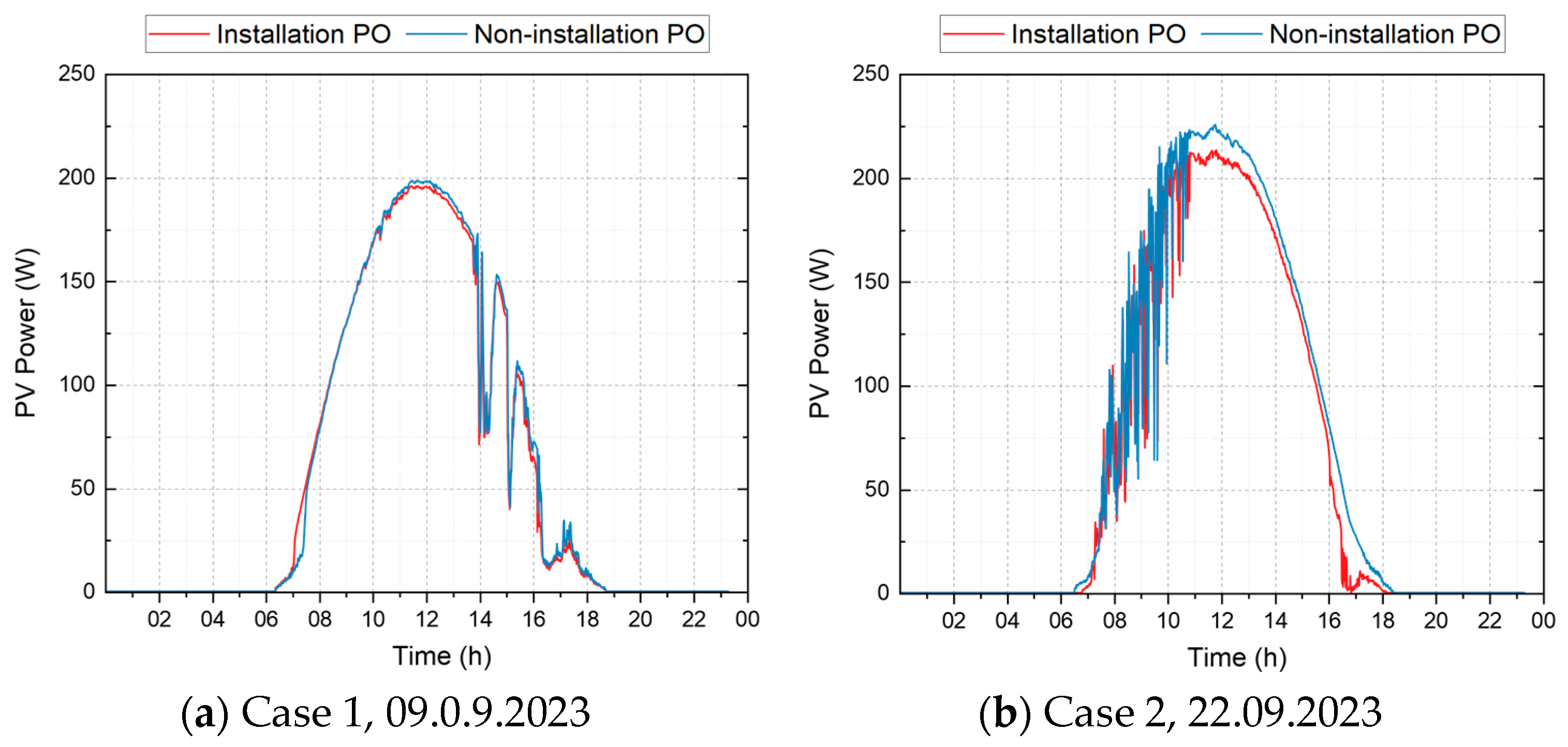
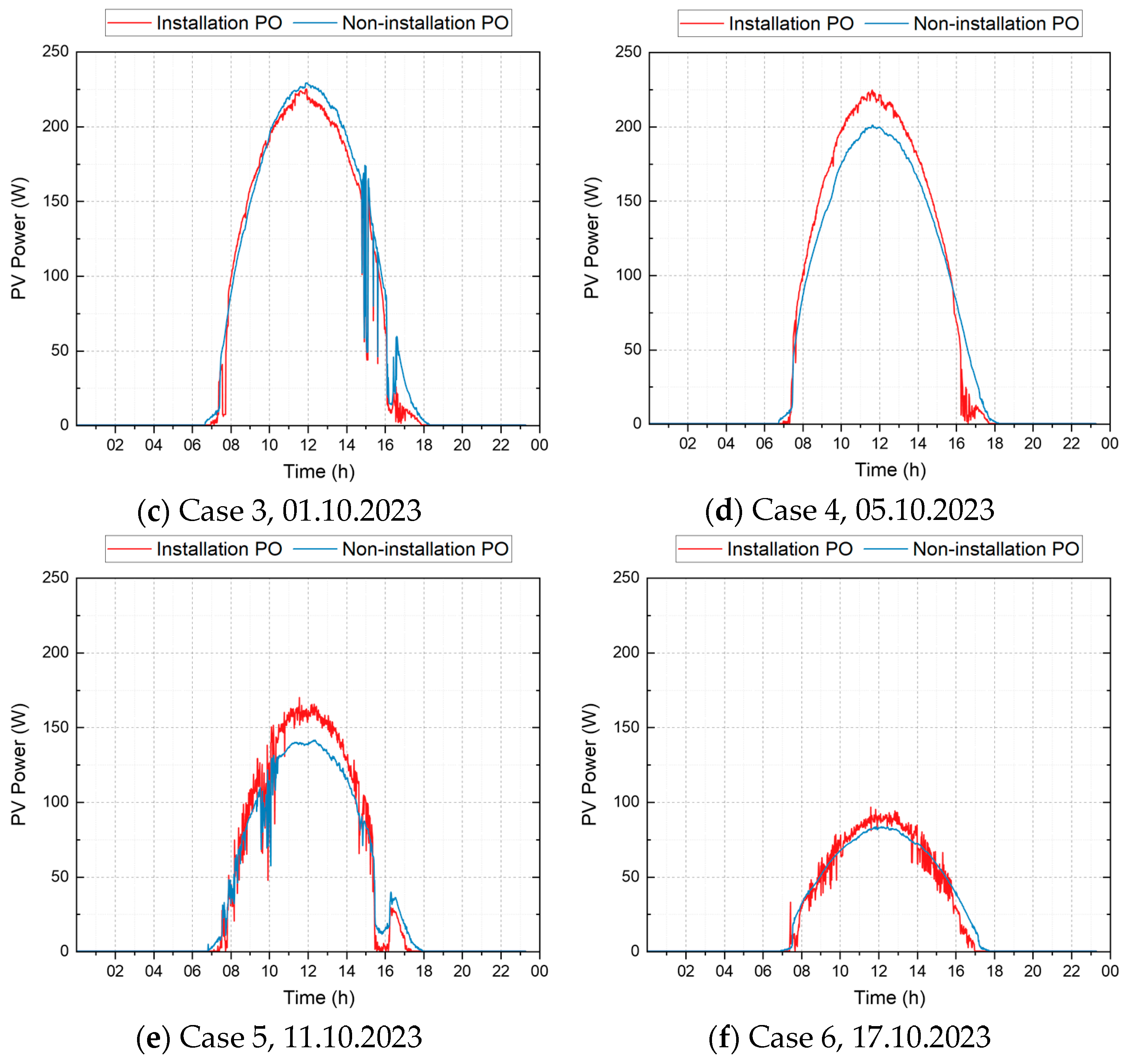
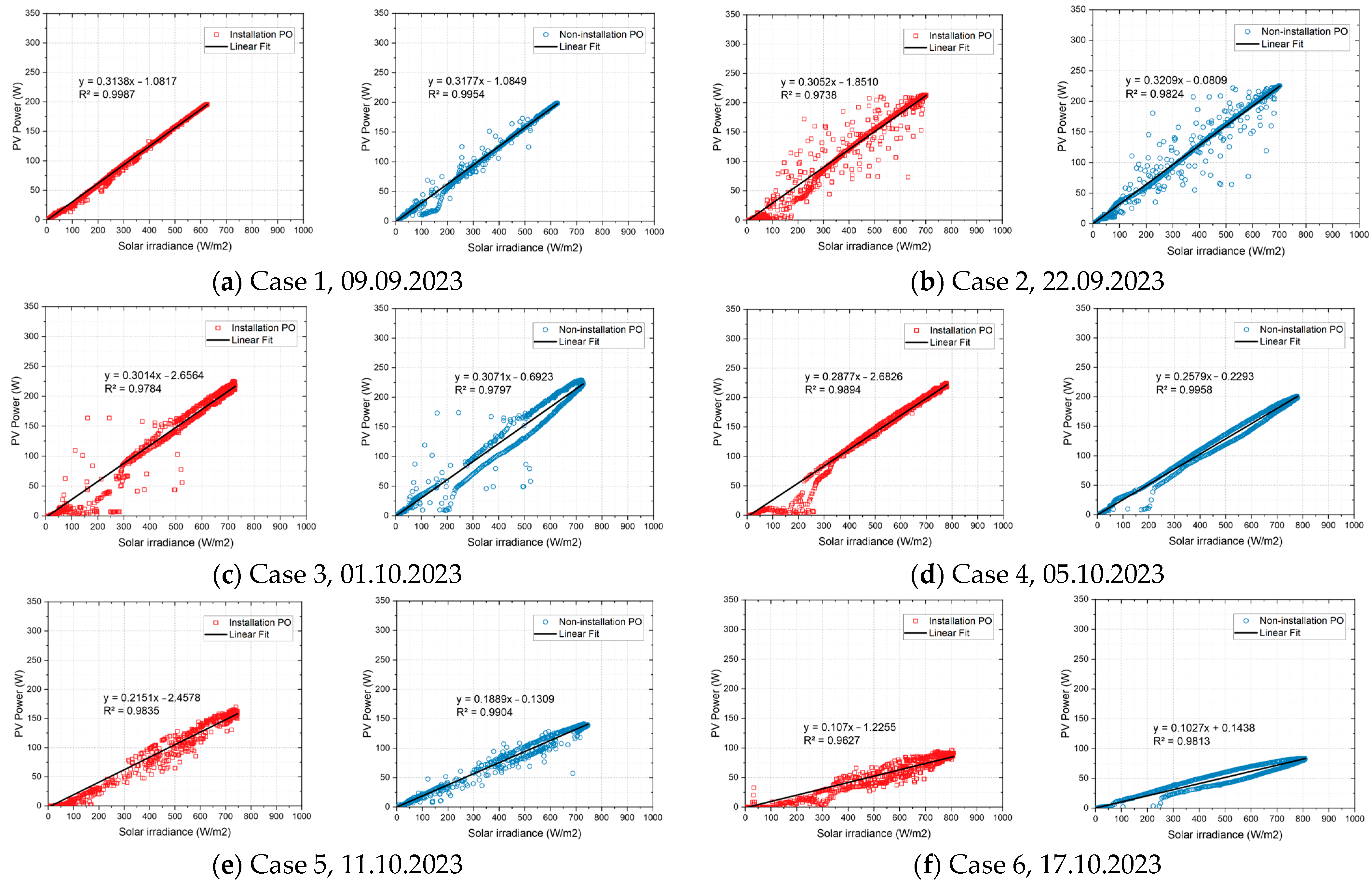
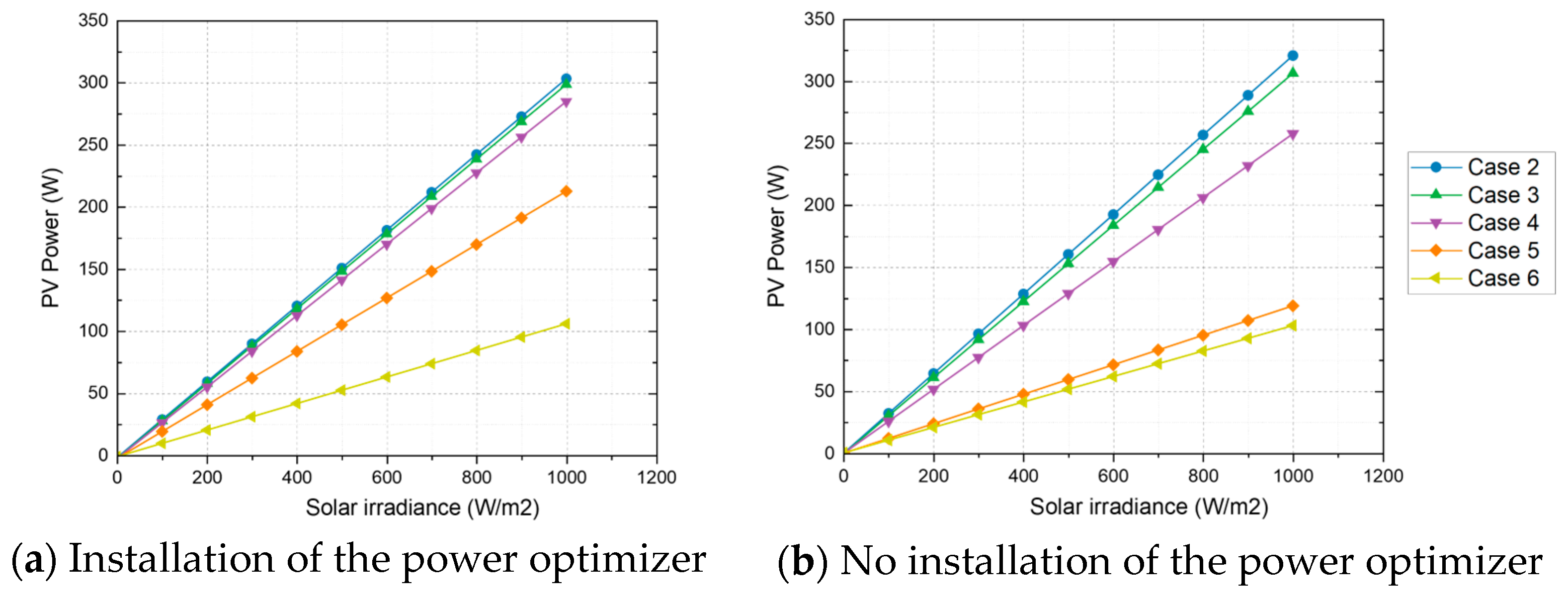

| Category | Front Side | Left Side | Roof Floor |
|---|---|---|---|
| Picture |  | 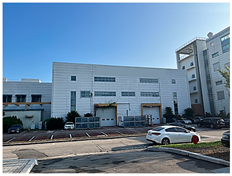 | 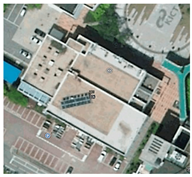 |
| Drawing |  | 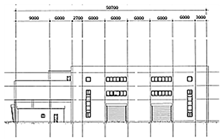 | 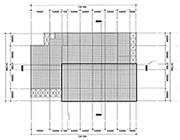 |
| Category | Parameter | Value |
|---|---|---|
| PV * System | Capacity [W] | 342 |
| Direction/Slope | South/90° | |
| PV Module | Rated power [W] | 171 |
| Maximum power voltage [V] | 20.77 | |
| Maximum power current [A] | 8.25 | |
| Open circuit voltage [V] | 24.2 | |
| Short circuit current [A] | 8.68 | |
| Efficiency [%] | 10.1, (B-b) 8.4 | |
| Cell material | Monocrystalline | |
| Cell configuration | 6 × 6 | |
| Dimensions (L × W × H) [mm] | 1462 × 1156 × 12, (B-b) 1762 × 1156 × 12 | |
| Weight [kg] | 47 | |
| Inverter | Rated power [W] | 350 |
| Input voltage range [V] | 16–60 | |
| Efficiency [%] | 94.79 | |
| Dimensions (L × W × H) [mm] | 178 × 153 × 28 | |
| Weight [kg] | 1.98 | |
| Power Optimizer | Rated input DC power [W] | 600 |
| Maximum input voltage [V] | 60 | |
| MPPT ** operating range [V] | 8–60 | |
| Dimensions (L × W × H) [mm] | 150 × 100 × 42 | |
| Weight [kg] | 0.625 |
| Case | Condition | I–V and V–P Curves in Simulation |
|---|---|---|
| 1 | No installation of the power optimizer |  |
| 2 | Installation of the power optimizer in module A |  Maximum power efficiency: 100% |
| 3 | Shading 10% of modules A-b and B-b along with the conditions of Case 2 | 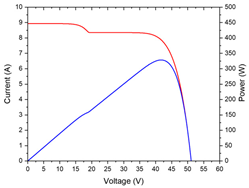 Maximum power efficiency: 95.8% |
| 4 | Shading 25% of modules A-b and B-b along with the conditions of Case 2 | 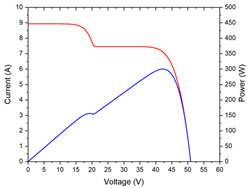 Maximum power efficiency: 87.6% |
| 5 | Shading 50% of modules A-b and B-b along with the conditions of Case 2 | 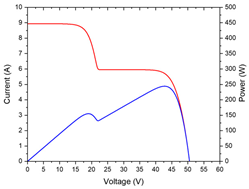 Maximum power efficiency: 71.2% |
| 6 | Shading 75% of modules A-b and B-b along with the conditions of Case 2 | 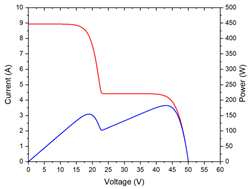 Maximum power efficiency: 53.3% |
| Case | Date | Weather (Mean Cloud Amount/d, Rainfall/d, Mean Temperature/d) | Solar Irradiance (kWh/m2/d) | Maximum PV Power (W) | PV Energy (kWh/d) | ||
|---|---|---|---|---|---|---|---|
| Installation PO * | Non-Installation PO | Installation PO | Non-Installation PO | ||||
| 1 | 9 September 2023 | 3.3, 0 mm, 25.8 °C | 4.20 | 196.1 (57.3%) | 198.8 (58.1%) | 1.29 (95.1%) | 1.31 (93.6%) |
| 2 | 22 September 2023 | 2.0, 0 mm, 20.5 °C | 4.66 | 213.5 (62.4%) | 225.8 (66.0%) | 1.38 (91.4%) | 1.49 (96.3%) |
| 3 | 1 October 2023 | 0.1, 0 mm, 18.4 °C | 5.04 | 225.2 (65.8%) | 229.3 (67.0%) | 1.45 (89.2%) | 1.53 (91.3%) |
| 4 | 5 October 2023 | 2.3, 0 mm, 14.2 °C | 5.39 | 224.7 (65.7%) | 201.0 (58.8%) | 1.49 (85.2%) | 1.39 (77.2%) |
| 5 | 11 October 2023 | 2.3, 0 mm, 17.6 °C | 4.67 | 170.0 (49.7%) | 141.5 (41.4%) | 0.95 (62.6%) | 0.88 (56.5%) |
| 6 | 17 October 2023 | 0.0, 0 mm, 13.8 °C | 5.52 | 96.5 (28.2%) | 83.4 (24.4%) | 0.56 (31.4%) | 0.57 (31.1%) |
Disclaimer/Publisher’s Note: The statements, opinions and data contained in all publications are solely those of the individual author(s) and contributor(s) and not of MDPI and/or the editor(s). MDPI and/or the editor(s) disclaim responsibility for any injury to people or property resulting from any ideas, methods, instructions or products referred to in the content. |
© 2023 by the authors. Licensee MDPI, Basel, Switzerland. This article is an open access article distributed under the terms and conditions of the Creative Commons Attribution (CC BY) license (https://creativecommons.org/licenses/by/4.0/).
Share and Cite
Eum, J.; Park, S.; Choi, H.-J. Effects of Power Optimizer Application in a Building-Integrated Photovoltaic System According to Shade Conditions. Buildings 2024, 14, 53. https://doi.org/10.3390/buildings14010053
Eum J, Park S, Choi H-J. Effects of Power Optimizer Application in a Building-Integrated Photovoltaic System According to Shade Conditions. Buildings. 2024; 14(1):53. https://doi.org/10.3390/buildings14010053
Chicago/Turabian StyleEum, Jiyoung, Seunghwan Park, and Hyun-Jung Choi. 2024. "Effects of Power Optimizer Application in a Building-Integrated Photovoltaic System According to Shade Conditions" Buildings 14, no. 1: 53. https://doi.org/10.3390/buildings14010053
APA StyleEum, J., Park, S., & Choi, H.-J. (2024). Effects of Power Optimizer Application in a Building-Integrated Photovoltaic System According to Shade Conditions. Buildings, 14(1), 53. https://doi.org/10.3390/buildings14010053






